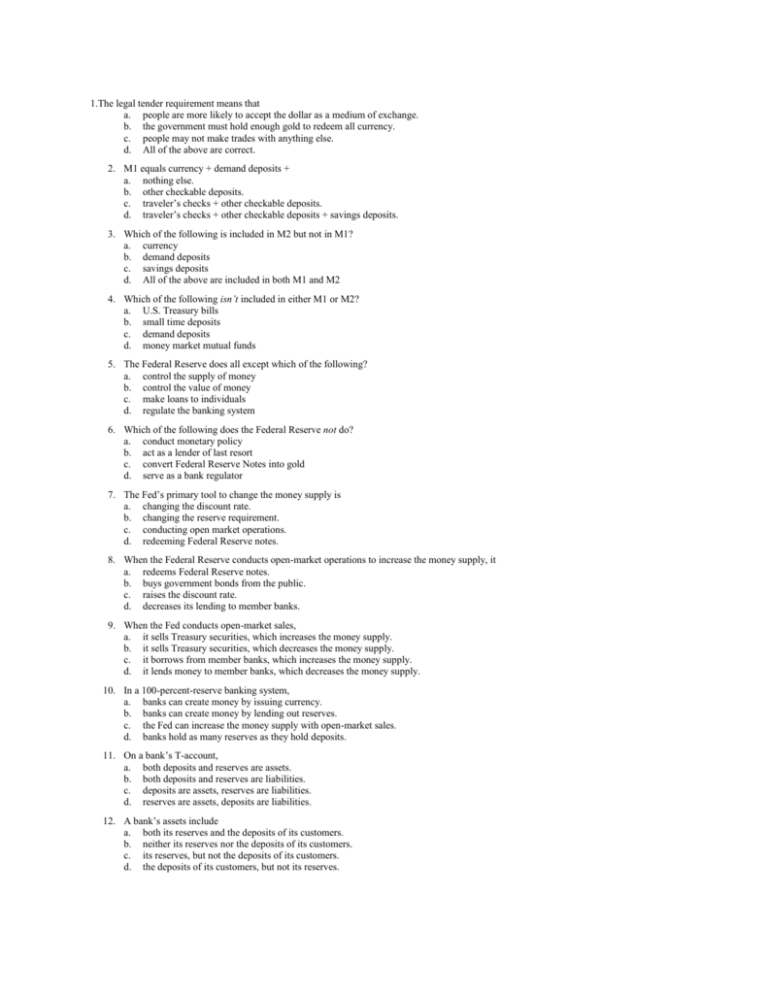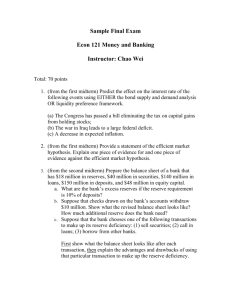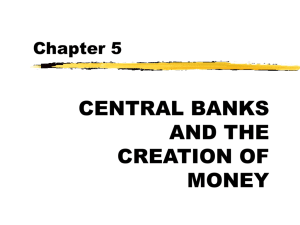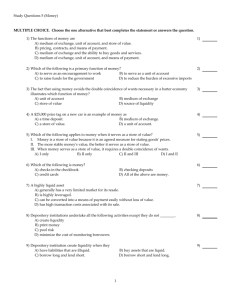ClassWork
advertisement

1.The legal tender requirement means that a. people are more likely to accept the dollar as a medium of exchange. b. the government must hold enough gold to redeem all currency. c. people may not make trades with anything else. d. All of the above are correct. 2. M1 equals currency + demand deposits + a. nothing else. b. other checkable deposits. c. traveler’s checks + other checkable deposits. d. traveler’s checks + other checkable deposits + savings deposits. 3. Which of the following is included in M2 but not in M1? a. currency b. demand deposits c. savings deposits d. All of the above are included in both M1 and M2 4. Which of the following isn’t included in either M1 or M2? a. U.S. Treasury bills b. small time deposits c. demand deposits d. money market mutual funds 5. The Federal Reserve does all except which of the following? a. control the supply of money b. control the value of money c. make loans to individuals d. regulate the banking system 6. Which of the following does the Federal Reserve not do? a. conduct monetary policy b. act as a lender of last resort c. convert Federal Reserve Notes into gold d. serve as a bank regulator 7. The Fed’s primary tool to change the money supply is a. changing the discount rate. b. changing the reserve requirement. c. conducting open market operations. d. redeeming Federal Reserve notes. 8. When the Federal Reserve conducts open-market operations to increase the money supply, it a. redeems Federal Reserve notes. b. buys government bonds from the public. c. raises the discount rate. d. decreases its lending to member banks. 9. When the Fed conducts open-market sales, a. it sells Treasury securities, which increases the money supply. b. it sells Treasury securities, which decreases the money supply. c. it borrows from member banks, which increases the money supply. d. it lends money to member banks, which decreases the money supply. 10. In a 100-percent-reserve banking system, a. banks can create money by issuing currency. b. banks can create money by lending out reserves. c. the Fed can increase the money supply with open-market sales. d. banks hold as many reserves as they hold deposits. 11. On a bank’s T-account, a. both deposits and reserves are assets. b. both deposits and reserves are liabilities. c. deposits are assets, reserves are liabilities. d. reserves are assets, deposits are liabilities. 12. A bank’s assets include a. both its reserves and the deposits of its customers. b. neither its reserves nor the deposits of its customers. c. its reserves, but not the deposits of its customers. d. the deposits of its customers, but not its reserves. 13. A bank’s liabilities include a. both its reserves and the deposits of its customers. b. neither its reserves nor the deposits of its customers. c. its reserves, but not the deposits of its customers. d. the deposits of its customers, but not its reserves. 14. Suppose a bank has a 10 percent reserve requirement, $5,000 in deposits, and has loaned out all it can given the reserve requirement. a. It has $50 in reserves and $4,950 in loans. b. It has $500 in reserves and $4,500 in loans. c. It has $555 in reserves and $4,445 in loans. d. None of the above is correct. 15. Suppose the banking system currently has $300 billion in reserves, that the reserve requirement is 10%, and that $3 billion of the reserves are excess reserves that will not be lent out. What is the value of deposits? a. $3,300 billion b. $2,970 billion c. $2,700 billion d. $2,673 billion 16. If the reserve ratio is 2.5 percent, the money multiplier is a. 40. b. 25. c. 2.5. d. 1.25. 17. If the reserve ratio is 4 percent, the money multiplier is a. 25 b. 20 c. 4 d. 2 19.If the Fed wanted to increase the money supply, it would make open market a. purchases and lower the discount rate. b. sales and lower the discount rate. c. purchases and raise the discount rate. d. sales and raise the discount rate. 20. To increase the money supply, the Fed could a. sell government bonds. b. increase the discount rate. c. decrease the reserve requirement. d. None of the above is correct. 21. To increase the money supply, the Fed could a. sell government bonds. b. decrease the discount rate. c. increase the reserve requirement. d. None of the above is correct. 22. To decrease the money supply, the Fed could a. sell government bonds. b. increase the discount rate. c. increase the reserve requirement. d. All of the above are correct. 23 Suppose that the reserve ratio is 5 percent and that a bank has $1,000 in deposits. Its reserves are a. $5. b. $50. c. $95. d. $950.








